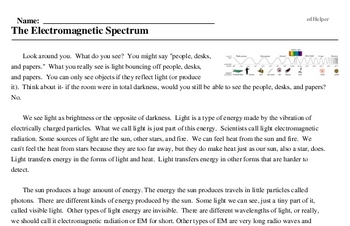The Electromagnetic Spectrum
Look around you. What do you see? You might say "people, desks, and papers." What you really see is light bouncing off people, desks, and papers. You can only see objects if they reflect light (or produce it). Think about it- if the room were in total darkness, would you still be able to see the people, desks, and papers? No.
We see light as brightness or the opposite of darkness. Light is a type of energy made by the vibration of electrically charged particles. What we call light is just part of this energy. Scientists call light electromagnetic radiation. Some sources of light are the sun, other stars, and fire. We can feel heat from the sun and fire. We can't feel the heat from stars because they are too far away, but they do make heat just as our sun, also a star, does. Light transfers energy in the forms of light and heat. Light transfers energy in other forms that are harder to detect.
The sun produces a huge amount of energy. The energy the sun produces travels in little particles called photons. There are different kinds of energy produced by the sun. Some light we can see, just a tiny part of it, called visible light. Other types of light energy are invisible. There are different wavelengths of light, or really, we should call it electromagnetic radiation or EM for short. Other types of EM are very long radio waves and very short wavelengths like x-rays and gamma rays. Electromagnetic energy doesn't need matter to travel through. That's a good thing for us! Because there's not much matter in space, we wouldn't get energy from the sun if light needed to travel through matter.
Energy travels from the sun in photons that move in waves. Each wave contains many different kinds of light; some we can see, and some we cannot. All light- visible and invisible- is part of the electromagnetic spectrum. Every kind of light travels in waves, like ripples in a pond or like ocean waves. A light's wavelength determines whether we can see it or not, and it determines what color we see. Light waves carry both electric and magnetic energy. Gamma, x-rays, ultraviolet (UV), visible, infrared, microwaves, and radio waves are all the forms of EM. This is called the electromagnetic spectrum.




